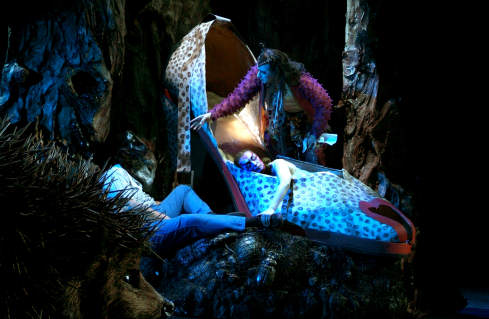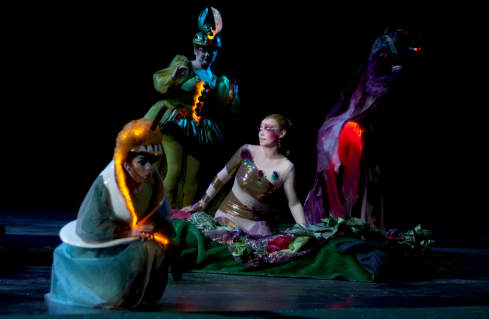Other Links
Editorial Board
-
Editor - Bill Kenny
Founder - Len Mullenger
Google Site Search
SEEN
AND HEARD INTERNATIONAL OPERA REVIEW
Britten, A Midsummer Night's Dream (Le Songe d'une
Nuit d'Eté):
Soloists, chorus and orchestra of the Opéra Toulon
Provence Méditerranée, co-production with the Opéra
de Nancy; Toulon, France. 9.12.2008 (MM)
Though overflowing with very beautiful music,
Benjamin Britten's A Midsummer Night's Dream
is not often included in the international Britten
repertory. Now, it has suddenly appeared on the
programs of both the Opera Provence Mediterranée of
Toulon and the Metropolitan Opera of New York!
The production challenges of A Midsummer Night's
Dream are formidable too and consequently quite
expensive. It is for fourteen essentially principal
artists (thirteen singers, one actor) who perform a
myriad of ensemble scenes for which music and
staging require extended rehearsal. This challenge
was well met by the Toulon Opera (12.9.2008) as the
triumph of this production was its well-prepared
cast.

Shakespeare's famous play does not exploit his usual
forceful characters to drive the action. Rather, it
is an essay on the psychologies of love that reside
in the pastoral poems and plays of the Renaissance.
These old pastorals explore the realms of love veiled
in now unfamiliar metaphors and vocabulary, and
though they are finally unsubtle in meaning they are
indeed remote from contemporary sensibility.
Britten's musical setting of Shakespeare's bizarre
pastoral play A Midsummer Night's Dream
unfolds almost word for word (only the first act is
missing), but Britten adds his usual sexual
complexities. He frames the love stories with the
sexually innocent voices of young boys, a Britten
obsession, and uses the solo sounds of rare
percussion instruments, the solo voices of wind
instruments, and the unusual sliding sounds of bowed
stringed instruments to create the compulsions and
contradictions of an indefinable world of sexual
attractions.
Britten's more well known operas, Peter Grimes
(1945) and Death in Venice (1973) mark the
first and last of his sixteen operas, of which only
another four are tip-of-the-tongue titles. Composed
exactly at midpoint of Britten's career A
Midsummer Night's Dream (1959) is unlikely to
join this primary group of operas because it presents
significant challenges. As hinted at already,
foremost perhaps is the difficulty of the pastoral
genre for contemporary audiences. This problem
raises a complementary issue -- why pay the price of
producing an opera that will puzzle (or more likely
may induce dreamless sleep, even an early departure
from the theater) far more than it will please a
modern audience.

This was an ensemble of excellent singers with
suitably beautiful voices, ll of whom were believable
actors as well. Oberon, composed for counter-tenor
Alfred Deller (he famously lacked a good high
register), was taken by Rachid Ben Abdeslam, a
Moroccan. who boasts a beautiful lower register (and,
well, rather like Deller, seems to lack a higher
one). Chinese soprano Maïra Kerey brought a sense of
the exotic to the fiendish role of Tytania though she
did not find the humanity in the role.
Trouble-maker Puck, the third principal fairy, was
gracefully executed by American actor Scott Emerson.
The sextet of lovers was led by the fine Canadian bass Randall
Jakobsch as Theseus, and by the rich voiced French contralto Elodie
Méchain as the Amazon Hippolyta, his bride. The Hermia of French
mezzo-soprano Delphine Galou did indeed finally bag her Lysander,
American tenor Jonathan Boyd. The Helena of French soprano Marjorie
Muray also bagged her Demetrius, French baritone Jean-Sébastien Bou.
Both women proved themselves the best badminton players during the
lovers' initial match. (See below.)
Three of five lively Athenian workers were Frenchmen; the Quince of
bass Jean Teitgen, the Snout of tenor Christophe Berry and the
particularly effective Starveling of baritone Thomas Dolié. Snug
was the fine Israeli bass Yuri Kissin, and Flute, the Peter Pears
role in the original production, was sung by Swiss tenor François
Piolino.
Bottom, finally, was roundly brought to real life by an authentic
speaker of Her Majesty's English, Scottish bass-baritone Iain
Paterson. This fact made a difference as his lines sailed clearly
and comprehensibly across the footlights (when not muffled by the
poorly designed ass's head). While the English pronunciation of the
other artists was well realized, the inclusion of this native
speaker made it apparent that, like Pelléas et Melisande, A
Midsummer Night's Dream remains a play, for which the addition
of music, any music, is an intrusion. One yearned for Shakespeare.
In 1959 Benjamin Britten could not have envisioned the elaborate
scenic and costume standards which have slowly and surely taken over
opera houses during the past fifty years. For Britten, the staging
of A Midsummer Night's Dream would have been minimal, the
ambience created by the extensive tone painting and quotes of
natural sounds emanating from his highly articulate orchestra. In
fact in photographs of the original production the stage was bare,
and the costumes minimal -- perhaps ideal for a musical setting of a
play that is an exposition of ideas.
Toulon mounted a well-conceived and realized production (a
co-production with the Opéra de Nancy where it was first performed
last June) that thoroughly illustrated the three worlds of
Shakespeare's play. It was ably directed by Jean-Louis Martinoty, a
former assistant to the legendary opera director Jean-Pierre
Ponnelle, who has had a decades long career staging rare repertory
operas, often in important theaters. However it is unclear if the
Toulon/Nancy production conception was Mr. Martinoty’s own as he was
an eleventh hour replacement for the original director, Omar Porras.
The scenery was designed by Bernard Arnould in bold strokes that
accommodated the limitations of provincial opera to the contemporary
expectation of elaborate illustration. He used only a badminton
court and a two-sided tree trunk, amended on one side by a giant
high-heeled shoe. The costumes were quite effective too, the lovers
in white suits which became soiled and torn as their adventures
evolved. The fairies' costumes were insect inspired, made
fantastical by hundreds of little lights, and the Athenians plebs
were rendered as generic rustics, Bottom stumbling onto another
high-heeled woman's shoe that induced his dream. Lighting, the work
of Fabrice Kebour, surely established the fantastic nature of the
sets and costumes.
The conductor was Britten specialist Steuart Bedford who ably kept
musical control of the complex ensembles perhaps at the expense of
more sweeping musical values, though certainly Britten's eerie fairy
music, his rich love music and his rough character music were
competently projected. Toulon's pit was stuffed with Britten's
percussion instruments, leaving room only for the minimum required
strings -- twelve players (the Met will undoubtedly enrich the sound
with many more). It is understandable, if unfortunate, that Toulon
replaced Britten's boys chorus with women, though gratefully four
mute young boy fairies did in fact appear at the appropriate moments
to establish an ironic background of sexual innocence.
This excellent production qualifies as one of Toulon Opera's finest
moments.
Michael Milenski
